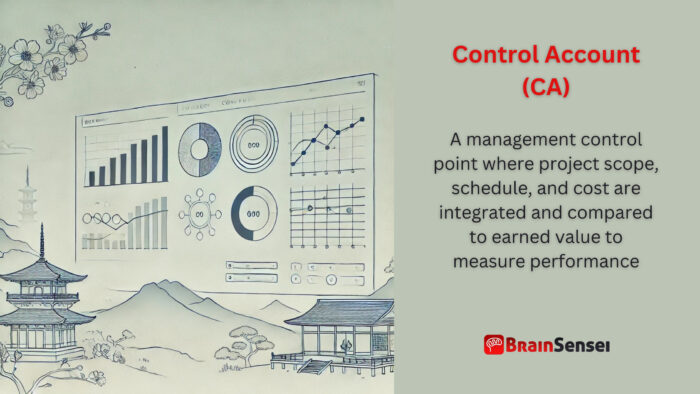
Control Account
What is a Control Account (CA)?
A control account (CA) is a management control point where project scope, schedule, and cost are integrated and compared to earned value to measure performance. It bridges high-level project plans and detailed work execution, giving project managers critical insights into project performance.
Key Takeaways
- Serves as a control point for measuring project performance
- Integrates scope, schedule, and cost data
- Supports earned value management (EVM) practices
- Provides insights for proactive decision-making
- Enhances project visibility for stakeholders
Understanding the Control Account
How It Works
During project planning, project managers establish control accounts, typically aligning them with the Work Breakdown Structure (WBS) and Organizational Breakdown Structure (OBS). Each account is then overseen by a designated Control Account Manager (CAM). The CAM plays a crucial role in tracking progress, analyzing variances, and implementing corrective actions, thereby ensuring the project stays on track.
Key Aspects
- Aligns with work packages and planning packages
- Utilizes baseline data for performance comparison
- Generates performance reports for informed decisions
- Requires regular reviews and updates to maintain accuracy
Notes
- Must be defined clearly during the project planning phase
- Overly detailed accounts may complicate performance tracking
- Regular audits ensure data integrity
- Should align with project objectives and milestones
- Practical CAM training is essential for success
Related Terms
- Work Breakdown Structure (WBS): A hierarchical decomposition of project work into manageable sections.
- Earned Value Management (EVM): A technique for measuring project performance by comparing planned vs. actual progress.
- Control Account Plan (CAP): A documented plan detailing a specific control account’s scope, schedule, and cost.
- Baseline: The approved project scope, schedule, and cost data version.
- Variance Analysis: Identifying and analyzing deviations from the project plan.
Examples of Control Account Application
Manufacturing Industry
A car manufacturing company uses control accounts to monitor the assembly of key components like engines, transmissions, and bodywork. The production manager tracks performance metrics against planned schedules and budgets to identify production bottlenecks early. By monitoring costs and production timelines through a detailed structure, the company can proactively address potential delays, allocate resources more effectively, and maintain production efficiency. Regular reviews of the performance data help the management team make informed decisions about process improvements and equipment investments.
For instance, when the engine assembly line shows a variance from the baseline due to a supplier delay, the project team quickly reallocates resources to minimize the impact on the production schedule. Additionally, the control account provides insights into cost performance, helping the finance team adjust budgets as needed.
Healthcare Industry
Control accounts help track medical equipment installation in a hospital construction project. By integrating costs, schedules, and equipment installation progress, project managers ensure timely and budget-compliant project execution. The hospital divided the project into several accounts, each corresponding to a significant work package, such as structural construction, HVAC installation, and medical equipment procurement.
During the equipment installation, project managers use reports to monitor the delivery and installation of critical devices like MRI machines. When the reports show installation is behind schedule, the team investigates the root cause—a delay in electrical wiring—and takes corrective action. This proactive management approach ensures the project remains on track for the hospital’s planned opening date.
Aerospace Industry
An aerospace firm uses control accounts to manage the development of aircraft components. They consolidate performance data from various departments to assess project health and support strategic decisions. The development project includes accounts for avionics, propulsion, and airframe design, each overseen by a dedicated CAM.
For example, when cost reports from the propulsion account indicate an unexpected expense increase, the CAM investigates and finds that supplier costs have risen due to material shortages. By analyzing the cost variance early, the project team negotiates with alternative suppliers to control costs without compromising quality. Additionally, the schedule data integration helps the team coordinate testing and assembly activities, ensuring the aircraft’s development is on schedule.
These examples illustrate how control accounts provide a structured framework for managing complex projects across different industries, enhancing performance visibility and enabling data-driven decision-making.
Use Cases of Control Accounts
United States (IT & Software)
A tech company implementing a new data center uses control accounts to track infrastructure development. By monitoring deviations from the baseline, project managers identify cost overruns early and implement corrective measures. The control account includes work packages for electrical installation, server deployment, and cooling system integration.
The project team tracks progress using earned value management (EVM) metrics like the Cost Performance Index (CPI) and Schedule Performance Index (SPI). When the SPI indicates a schedule delay, the CAM investigates the root cause—a delay in equipment delivery. The team mitigates the delay by adjusting resources and prioritizing critical path tasks. The control account also helps the finance department forecast remaining costs and reallocate budgets as needed to avoid overspending.
Germany (Renewable Energy)
A renewable energy project in Germany uses control accounts (CAMs) to oversee the installation of wind turbines. The CAM tracks performance and ensures adherence to regulatory requirements and project deadlines. The control account covers work packages such as foundation construction, turbine assembly, and grid connection.
During a performance review, the CAM notices a cost variance in the turbine assembly package. Analysis reveals that transportation costs exceed initial estimates due to fuel price increases. The project team minimizes cost impacts by renegotiating logistics contracts and optimizing delivery schedules. The control account also facilitates communication with regulatory authorities, ensuring compliance with environmental standards.
Japan (Construction)
A Japanese construction firm uses control accounts to manage high-rise building projects. They allocate resources efficiently and align progress with the project timeline. The control accounts encompass structural work, facade installation, and interior finishing.
The CAM detects a schedule variance in the facade installation phase as construction progresses. The investigation shows that labour shortages are causing delays. In response, the company partners with a labour agency to hire additional skilled workers. The control account reports are shared with senior management, enabling data-driven decisions to maintain project timelines.
These detailed use cases illustrate how control accounts are essential tools for performance management across diverse industries and regions. They provide a systematic approach to tracking, analyzing, and optimizing project performance.
Best Practices for Using Control Accounts
Implementing control accounts requires adherence to several best practices. Below are comprehensive strategies to ensure optimal results:
Define Clear Objectives
Start by establishing specific goals for each control account. Clear objectives provide direction and facilitate better performance measurement.
Align with Organizational Structures
Ensure control accounts align with the Work Breakdown Structure (WBS) and Organizational Breakdown Structure (OBS). This alignment enhances traceability and accountability.
Select Competent Control Account Managers (CAMs)
Assign experienced and trained CAMs to oversee control accounts. CAMs should thoroughly understand project management principles and earned value management (EVM).
Develop Detailed Control Account Plans
Create comprehensive Control Account Plans (CAPs) that include scope, schedule, cost baselines, and performance metrics. These plans serve as reference documents for tracking and decision-making.
Integrate Data Systems
Consolidate scope, schedule, and cost data using integrated software tools. Tools like Primavera P6, Microsoft Project, and Deltek Cobra facilitate real-time performance monitoring.
Conduct Regular Performance Reviews
Schedule frequent performance assessments to compare actual performance against the baseline. Regular reviews help identify variances early, allowing for timely corrective actions.
Implement Robust Change Management Procedures
Establish protocols to manage changes in project scope, schedule, or costs. Document, analyze, and approve change requests before implementation.
Use Earned Value Management (EVM) Metrics
Calculate and analyze key EVM indicators, such as Cost Performance Index (CPI) and Schedule Performance Index (SPI). These metrics provide insights into project health.
Foster Cross-Functional Collaboration
Encourage communication and collaboration among project teams, finance departments, and senior management. Collaborative efforts lead to more accurate and reliable performance data.
Provide Ongoing Training and Development
Invest in continuous training programs for CAMs and project staff. Up-to-date knowledge ensures better control of account management practices.
By following these best practices, organizations can maximize the effectiveness of their control accounts, ensuring more predictable and successful project outcomes.
Common Mistakes and Issues
Managing control accounts presents challenges that can impact project performance if not addressed appropriately. Here are some common mistakes and their implications:
Inconsistent Data Integration
Inaccurate performance assessments often result from inconsistent scope, schedule, and cost data integration. Lack of data integration and synchronization across multiple systems can result in decision-makers receiving incomplete or misleading information. For instance, a construction project might experience delays due to late reporting of actual costs, preventing timely corrective actions.
Lack of Control Account Management (CAM) Training
Assigning the role to undertrained personnel leads to misinterpretations and poor decisions. CAMs must understand the principles of Earned Value Management (EVM) and performance metrics to interpret variance reports accurately. Insufficient training can result in overlooked warning signs, such as subtle schedule delays that escalate into major disruptions.
Overly Complex Accounts
While detailed tracking can be beneficial, excessive granularity complicates data analysis and performance evaluation. For example, a manufacturing project with hundreds of accounts may find it difficult to identify critical performance trends if the data is unnecessarily detailed. Striking a balance between detail and clarity is essential.
Delayed Updates
Infrequent performance reviews and delayed data updates undermine the usefulness of control accounts. Real-time or regular updates ensure that performance reports reflect the project’s current state, allowing for timely interventions when issues arise.
Ignoring Variance Trends
Focusing solely on immediate performance deviations without considering historical trends can mask systemic problems. For example, a project might consistently show minor cost overruns that significantly impact the budget when aggregated over time.
Poor Communication
Control accounts require coordination between various departments, including project management, finance, and operations. Misaligned communication channels can result in discrepancies between reported and actual performance data.
Neglecting Risk Management
Failing to incorporate risk factors during planning leaves projects vulnerable to unforeseen events. Risk-adjusted performance metrics and scenario analyses help anticipate potential issues and implement preventive measures.
By recognizing and addressing these common mistakes, project teams can enhance the reliability and effectiveness of their control account management practices.
Frequently Asked Questions (FAQs)
What is the purpose of a control account?
A control account integrates scope, schedule, and cost data to provide a reference point for measuring and analyzing project performance.
Who manages a control account?
A designated CAM monitors, analyzes, and reports performance metrics.
How does a control account relate to earned value management?
Control accounts serve as the foundation for earned value management, enabling the calculation of performance indicators like CPI and SPI.
What tools do organizations use to manage control accounts?
Organizations use tools like Microsoft Project, Primavera P6, and Deltek Cobra.
Can a project have multiple control accounts?
Large projects often have multiple accounts, each focusing on a specific work package or deliverable.
Additional Resources
Preparing for a PMI certification?
- Exam Prep Courses: PMP®, CAPM®, and PMI-ACP®
- Exam Simulators: PMP®, CAPM®, PMI-ACP®, PMI-PBA®, PMI-RMP®, PMI-SP®, PgMP®, and PfMP®
- Professional Development Units (PDUs): 15, 30, and 60 PDU Bundles



